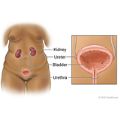How It Is Done
Before the test
The test is done in a hospital or the doctor's office.
You'll need to take off all or most of your clothes. You'll have a cloth or paper covering to use during the test.
If you are having this done in a hospital, you may get a sedative to help you relax about an hour before the test. An intravenous (I.V.) needle may be placed in your arm to give you other medicines and fluids.
You will lie on your back on a table. You may have your knees bent, legs apart. Your feet or thighs may be placed in stirrups. Your genital area is cleaned with an antiseptic solution. Your belly and thighs are covered with sterile cloths.
For this test, you will have one of three kinds of anesthesia.
- Local anesthetic. This anesthetic is inserted in your urethra.
- General anesthetic. You are put to sleep either with medicine through an IV or with gases inhaled through a mask. Sometimes both methods are used.
- Spinal anesthetic. The doctor or nurse first numbs the area on your back where the needle will be inserted. Then the needle is guided into the spinal canal and the anesthetic is injected. You may not be able to move your legs until the medicine wears off.
During the test
After the anesthetic takes effect, the cystoscope, or scope, is inserted into your urethra and moved into your bladder. If your urethra has a spot that is too narrow, other smaller tools are inserted first. They will gradually make it large enough for the scope.
Next, the doctor puts either sterile water or salt water (saline) into your bladder to make it larger and to create a clear view. The doctor may also put in medicine to reduce chances of infection.
The doctor can also insert tiny tools through the scope to collect tissue samples for biopsy. The tissue samples are sent to the lab to be checked.
After the test
If a local anesthetic is used, you may be able to get up right after the test. If a general anesthetic is used, you will stay in the recovery room until you are awake and able to walk. (This usually takes an hour or less.) You can eat and drink as soon as you are fully awake and can swallow without choking. If a spinal anesthetic was used, you will stay in the recovery room until feeling in your legs has returned. (This usually takes about an hour.)
How long the test takes
The cystoscope is usually in your bladder for only a few minutes. But if other X-ray tests or other procedures are done at the same time, the entire test may take up to 45 minutes or longer.


